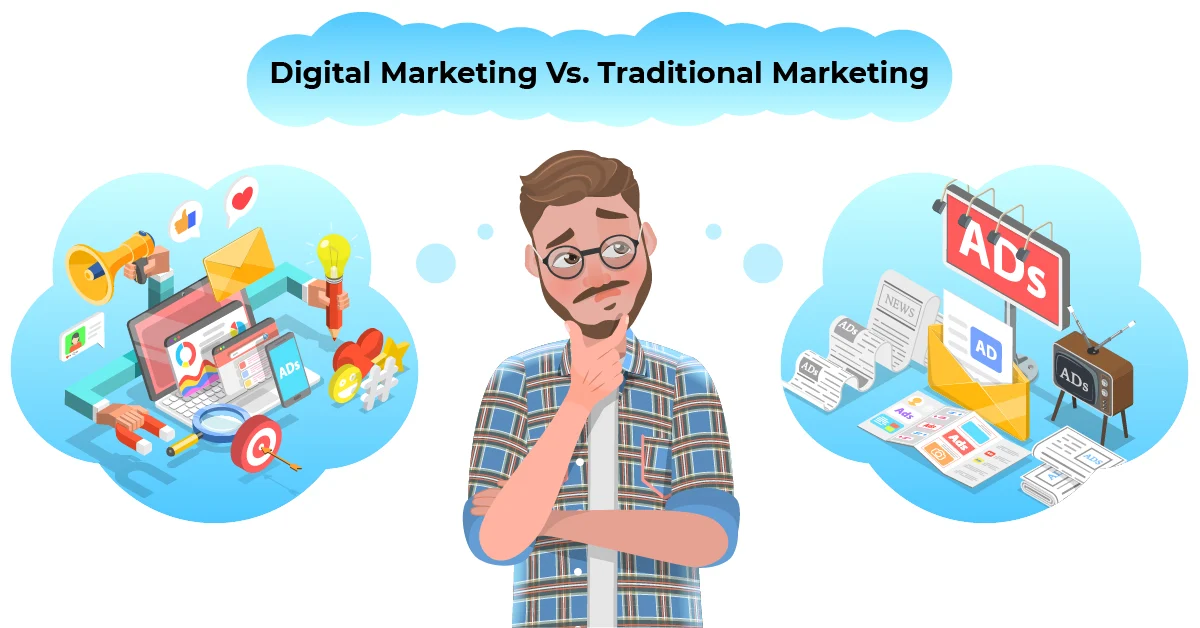
In today’s rapidly evolving business landscape, marketing strategies play a pivotal role in determining the success of a company. With the advent of technology, the age-old debate between digital marketing and traditional marketing has intensified. Both approaches offer unique benefits and challenges, making it essential for businesses to understand the nuances of each and choose the right mix to achieve their objectives.
Traditional marketing encompasses conventional advertising methods such as print ads, television and radio commercials, billboards, direct mail, and telemarketing. It relies on reaching out to a broad audience through traditional channels and has been the cornerstone of marketing for decades. On the other hand, digital marketing leverages the power of the internet and digital platforms to connect with a target audience through various online channels, including search engines, social media, email, and content marketing.
- Reach and Targeting:
Traditional marketing often casts a wide net, aiming to reach a large audience, including both potential and irrelevant customers. In contrast, digital marketing enables businesses to precisely target their ideal audience based on demographics, interests, and online behavior. This targeted approach allows for personalized messaging and higher chances of conversion. - Cost and ROI:
One significant advantage of digital marketing is its cost-effectiveness compared to traditional marketing. Digital channels often offer lower entry costs, and businesses have more control over their advertising budgets. Additionally, digital marketing allows for accurate tracking and analysis of campaign performance, enabling businesses to measure their return on investment (ROI) effectively. - Interactivity and Engagement:
Digital marketing offers unparalleled interactivity and engagement opportunities. Social media platforms, for instance, allow businesses to directly interact with their audience, gather feedback, and build relationships. The ability to create interactive content, such as quizzes, polls, and contests, enhances user engagement and brand loyalty. Traditional marketing, while effective in reaching a mass audience, lacks the same level of direct interaction and engagement. - Flexibility and Real-Time Optimization:
Digital marketing provides the flexibility to adapt campaigns in real-time. With the ability to monitor and analyze campaign performance, businesses can quickly identify what works and what doesn’t. They can then make data-driven adjustments to optimize their marketing efforts. Traditional marketing, however, often involves long lead times, making it challenging to make immediate changes or optimizations once a campaign is underway. - Measurability and Analytics:
One of the most significant advantages of digital marketing is the ability to measure and analyze results with precision. Businesses can track key performance indicators (KPIs) such as website traffic, conversion rates, click-through rates, and customer engagement. This data allows for continuous improvement and informed decision-making. Traditional marketing, on the other hand, relies more on estimated reach and lacks the same level of detailed analytics. - Global Reach and 24/7 Availability:
Digital marketing transcends geographical boundaries, enabling businesses to reach a global audience. With online platforms, businesses can operate around the clock, allowing customers to access information, make purchases, and interact with brands at their convenience. Traditional marketing often has limitations in terms of geographical reach and is constrained by operating hours.
In conclusion, both digital marketing and traditional marketing have their merits, and the ideal marketing strategy depends on various factors such as target audience, budget, industry, and goals. While traditional marketing can still be effective for certain businesses, digital marketing has undoubtedly revolutionized the way brands connect with their audience, offering unparalleled reach, targeting, interactivity, and measurable results. Striking the right balance between the two approaches can lead to a comprehensive and effective marketing strategy that drives business success in today’s dynamic marketplace.

